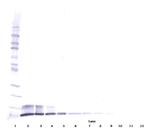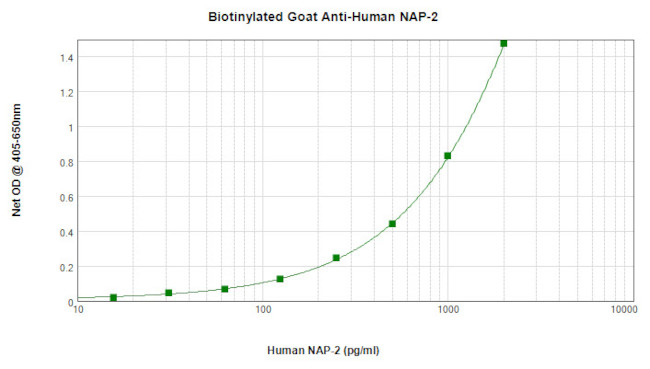Search Thermo Fisher Scientific
FIGURE: 1 / 3
PPBP Antibody (500-P03GBT-25UG) in ELISA



Product Details
500-P03GBT-25UG
Species Reactivity
Host/Isotype
Class
Type
Immunogen
Conjugate
Form
Concentration
Purification
Storage buffer
Contains
Storage conditions
Shipping conditions
RRID
Product Specific Information
AA Sequence of recombinant protein: AELRCMCIKT TSGIHPKNIQ SLEVIGKGTH CNQVEVIATL KDGRKICLDP DAPRIKKIVQ KKLAGDESAD.
Preparation: Produced from sera of goats immunized with highly pure Recombinant Human NAP-2 (CXCL7). Anti-Human NAP-2 (CXCL7)-specific antibody was purified by affinity chromatography and then biotinylated.
Sandwich ELISA: To detect Human NAP-2 by sandwich ELISA (using 100 µL/well) a concentration of 0.25-1.0 µg/mL of this antibody is required. This biotinylated polyclonal antibody, in conjunction with PeproTech Polyclonal Anti-Human NAP-2 (CXCL7) (500-P03) as a capture antibody, allows the detection of at least 2000-4000 pg/mL of Recombinant Human NAP-2.
Western Blot: To detect Human NAP-2 by Western Blot analysis this antibody can be used at a concentration of 0.1-0.2 µg/mL. When used in conjunction with compatible development reagents the detection limit for Recombinant Human NAP-2 is 1.5-3.0 ng/lane, under either reducing or non-reducing conditions.
500-P03GBT-1MG will be provided as 2 x 500 µg
Target Information
Members of the a-chemokine subfamily of inducible, secreted, pro-inflammatory cytokines contain a similar motif, in which the first two cysteine residues are separated by a single residue (Cys-X-Cys), and are also chemotactic for neutrophils. The platelet basic protein (PBP), a member of the a-chemokine family, resides in the a-granules of platelets and is released upon their activation. Proteolytic cleavage of the amino terminus of PBP leads to the generation of several peptides, which include mature PBP, connective tissue-activating peptide III (CTAP III, also designated low affinity platelet factor IV (LA-PF4)), b-thromboglobulin (b-TG), and neutrophil-activating peptide 2 (NAP-2). PBP and its N-truncated derivatives mediate inflammation and wound healing. Specifically, NAP-2 activates chemotaxis and degranulation in neutrophils during inflammation. The gene encoding human PBP maps to chromosome 4q12-q13.
For Research Use Only. Not for use in diagnostic procedures. Not for resale without express authorization.
References (0)
Bioinformatics
Protein Aliases: beta-thromboglobulin; C-X-C motif chemokine 7; chemokine (C-X-C motif) ligand 7; connective tissue-activating peptide III; CXC chemokine ligand 7; LDGF; Leukocyte-derived growth factor; low-affinity platelet factor IV; Macrophage-derived growth factor; MDGF; neutrophil-activating peptide 2; neutrophil-activating peptide-2; PBP; Platelet basic protein; pro-platelet basic protein (chemokine (C-X-C motif) ligand 7); small inducible cytokine B7; small inducible cytokine subfamily B, member 7; Small-inducible cytokine B7; thrombocidin 1; thrombocidin 2; thromboglobulin, beta-1
Gene Aliases: B-TG1; Beta-TG; CTAP-III; CTAP3; CTAPIII; CXCL7; LA-PF4; LDGF; MDGF; NAP-2; PBP; PPBP; SCYB7; TC1; TC2; TGB; TGB1; THBGB; THBGB1
UniProt ID: (Human) P02775
Entrez Gene ID: (Human) 5473

Performance Guarantee
If an Invitrogen™ antibody doesn't perform as described on our website or datasheet,we'll replace the product at no cost to you, or provide you with a credit for a future purchase.*
Learn more
We're here to help
Get expert recommendations for common problems or connect directly with an on staff expert for technical assistance related to applications, equipment and general product use.
Contact tech support
